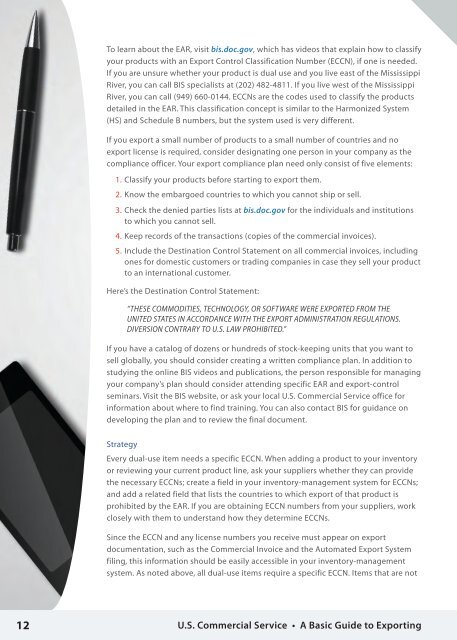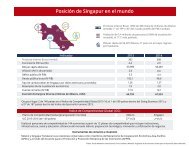basic-guide-to-exporting_Latest_eg_main_086196
basic-guide-to-exporting_Latest_eg_main_086196
basic-guide-to-exporting_Latest_eg_main_086196
Create successful ePaper yourself
Turn your PDF publications into a flip-book with our unique Google optimized e-Paper software.
To learn about the EAR, visit bis.doc.gov, which has videos that explain how <strong>to</strong> classifyyour products with an Export Control Classification Number (ECCN), if one is needed.If you are unsure whether your product is dual use and you live east of the MississippiRiver, you can call BIS specialists at (202) 482-4811. If you live west of the MississippiRiver, you can call (949) 660-0144. ECCNs are the codes used <strong>to</strong> classify the productsdetailed in the EAR. This classification concept is similar <strong>to</strong> the Harmonized System(HS) and Schedule B numbers, but the system used is very different.If you export a small number of products <strong>to</strong> a small number of countries and noexport license is required, consider designating one person in your company as thecompliance officer. Your export compliance plan need only consist of five elements:1. Classify your products before starting <strong>to</strong> export them.2. Know the embargoed countries <strong>to</strong> which you cannot ship or sell.3. Check the denied parties lists at bis.doc.gov for the individuals and institutions<strong>to</strong> which you cannot sell.4. Keep records of the transactions (copies of the commercial invoices).5. Include the Destination Control Statement on all commercial invoices, includingones for domestic cus<strong>to</strong>mers or trading companies in case they sell your product<strong>to</strong> an international cus<strong>to</strong>mer.Here’s the Destination Control Statement:“THESE COMMODITIES, TECHNOLOGY, OR SOFTWARE WERE EXPORTED FROM THEUNITED STATES IN ACCORDANCE WITH THE EXPORT ADMINISTRATION REGULATIONS.DIVERSION CONTRARY TO U.S. LAW PROHIBITED.”If you have a catalog of dozens or hundreds of s<strong>to</strong>ck-keeping units that you want <strong>to</strong>sell globally, you should consider creating a written compliance plan. In addition <strong>to</strong>studying the online BIS videos and publications, the person responsible for managingyour company’s plan should consider attending specific EAR and export-controlseminars. Visit the BIS website, or ask your local U.S. Commercial Service office forinformation about where <strong>to</strong> find training. You can also contact BIS for guidance ondeveloping the plan and <strong>to</strong> review the final document.Strat<strong>eg</strong>yEvery dual-use item needs a specific ECCN. When adding a product <strong>to</strong> your inven<strong>to</strong>ryor reviewing your current product line, ask your suppliers whether they can providethe necessary ECCNs; create a field in your inven<strong>to</strong>ry-management system for ECCNs;and add a related field that lists the countries <strong>to</strong> which export of that product isprohibited by the EAR. If you are obtaining ECCN numbers from your suppliers, workclosely with them <strong>to</strong> understand how they determine ECCNs.Since the ECCN and any license numbers you receive must appear on exportdocumentation, such as the Commercial Invoice and the Au<strong>to</strong>mated Export Systemfiling, this information should be easily accessible in your inven<strong>to</strong>ry-managementsystem. As noted above, all dual-use items require a specific ECCN. Items that are not12U.S. Commercial Service • A Basic Guide <strong>to</strong> Exporting





